The SETI Institute (Search for Extraterrestrial Intelligence), launched as a flagship global initiative to search for intelligent life beyond Earth, began operations on February 1, 1985. For the first time in history, there were professionals whose day-to-day job was to look for intelligent signals from the cosmos. The project was founded by legendary astrophysicist and science communicator Carl Sagan and his colleagues, inspired by early ideas of an intelligent universe dating back to the 1960s. Their view of the cosmos now seems almost naively optimistic: they believed that contact with other civilizations was only a matter of time—soon, even.
Four decades have passed—and still no answer. It’s becoming harder to keep the faith. Yet the paradox is this: right now, there is mounting evidence that Earth is not unique, and the key "ingredients of life" are far more common in space than anyone imagined back in 1985. The search continues—albeit on a different level, with different technologies and a new understanding of the question itself.
The Origins of SETI: How Gamma Rays and Wavelength Debates Sparked the Search for Extraterrestrial Intelligence
In the public imagination, the SETI project is most often associated with Carl Sagan. As the creator and host of the iconic science series "Cosmos"—and later the screenwriter of the film "Contact"—he introduced millions of people in the U.S. and beyond to the world of astrophysics, inspiring them with a characteristically optimistic worldview of the time: intelligence in the universe wasn’t just possible, it was all but inevitable. But in reality, SETI didn’t have a single founding father. It was a project with many origins, where the ideas of scientists, dreamers, and engineers eventually converged into one ambitious attempt to hear a voice from space.
One of the thinkers whose ideas helped lay the foundation for SETI was physicist Philip Morrison—a student of Robert Oppenheimer and a participant in the Manhattan Project. After World War II, Morrison left Los Alamos, disillusioned with military science, and became an outspoken advocate for arms control. Instead of building new bombs, Morrison turned his gaze to the cosmos—specifically to the study of gamma radiation, the most energetic form of electromagnetic waves in nature.
Gamma rays are produced both by nuclear explosions on Earth and by similarly cataclysmic processes in the depths of the universe. It was in this overlap of past and future—from the physics of destruction to the physics of origin—that Morrison’s new scientific path took shape.

Gamma-ray pulsation from the Vela pulsar, recorded by the Fermi Large Area Telescope.
Philip Morrison himself described how the idea for SETI was born. Strangely enough, it happened during a chamber music evening at the student center of Cornell University. While listening to a string quartet, he began to wonder: what if gamma radiation could be used as a tool to study the universe? These thoughts evolved into a serious scientific paper, published in 1958. But the true moment of insight came later—when Morrison's colleague, astrophysicist Giuseppe Cocconi, walked into his office.
Cocconi, who was working with his wife Vanna on the nature of cosmic rays, had recently demonstrated that some of the high-energy particles reaching Earth could plausibly have an extragalactic origin. He asked Morrison what seemed like a strange question: could gamma rays be used for interstellar communication?
Morrison was intrigued. But as the two discussed the idea, they quickly realized that the issue wasn’t really about gamma rays themselves—it was about the broader concept of interstellar communication. "Shouldn’t we study the entire electromagnetic spectrum to find the optimal wavelength for communication?" Morrison later recalled. And thus, the idea of SETI was born. The question of wavelength soon led to another: what kind of message could actually travel through space and be recognized? And from there came the realization that it wasn’t enough to theorize—one had to listen to the cosmos systematically, methodically, with scientific persistence.
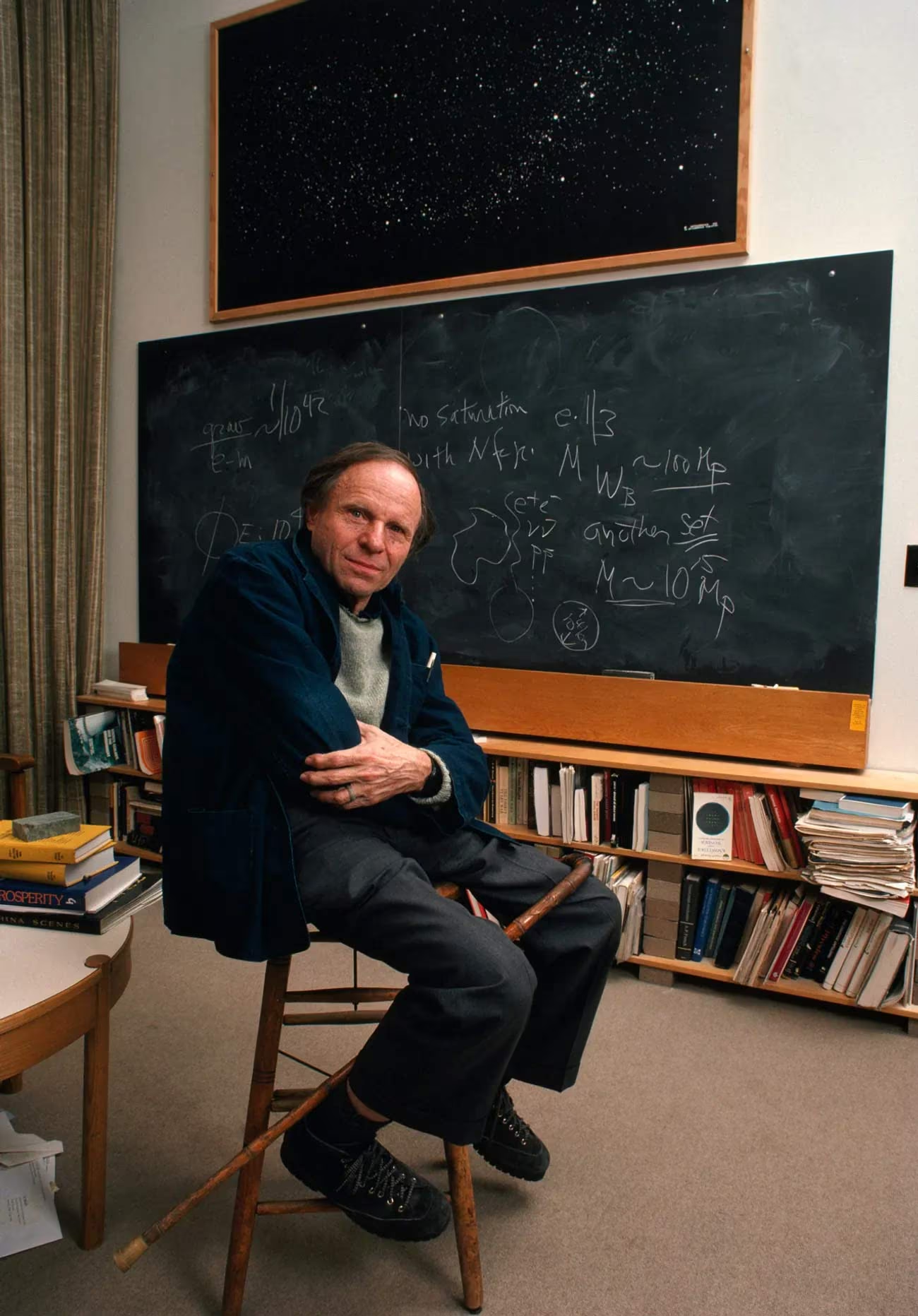
Philip Morrison.
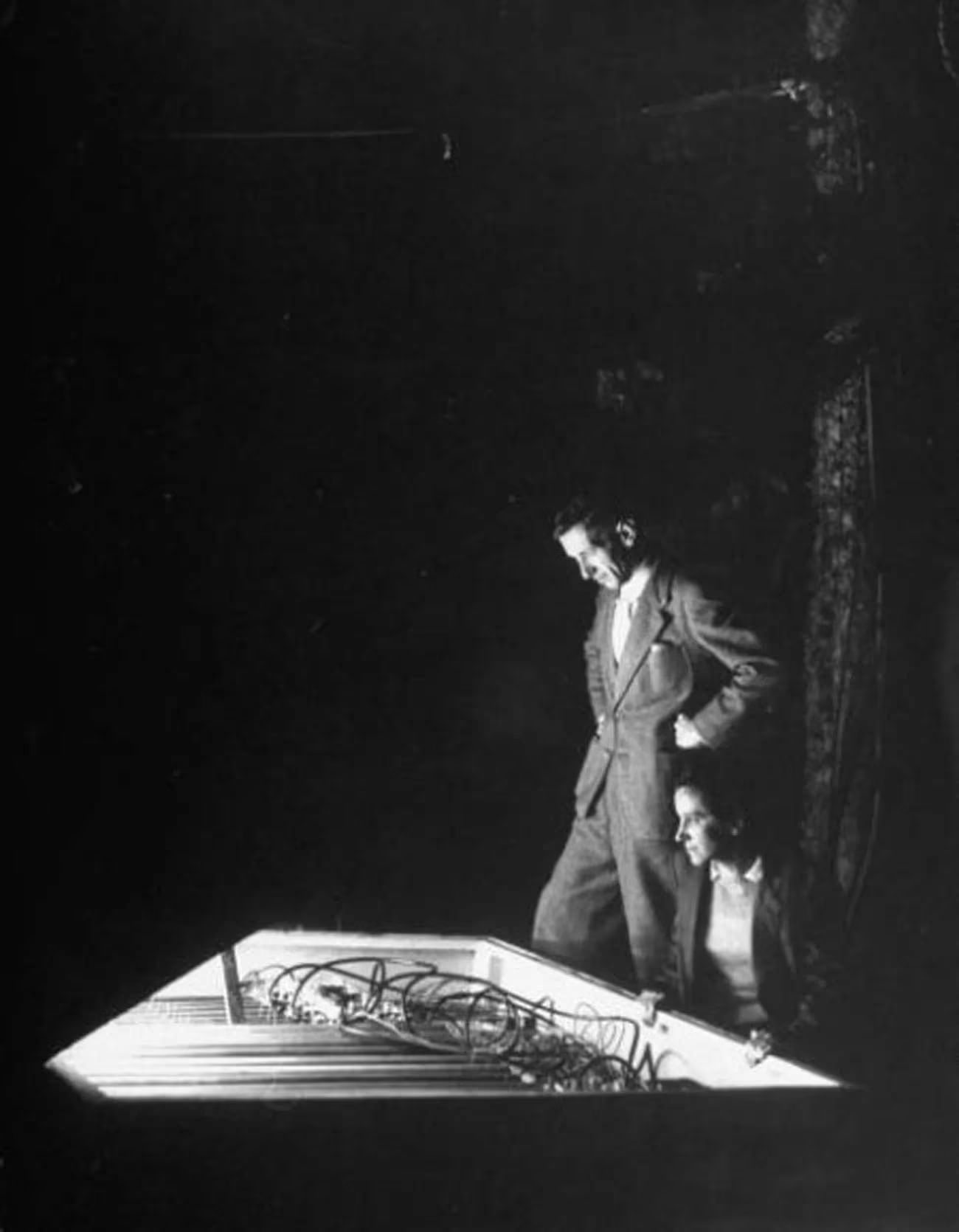
Vanna and Giuseppe Cocconi.
Cocconi and Morrison laid out their initial conclusions in 1959 in a now-iconic article titled "Searching for Interstellar Communications," published in Nature. The text began with a simple, almost intuitive hypothesis: if intelligent beings exist elsewhere in the universe and are aware of us, they might try to make contact. To do so, they would need to be advanced enough to understand the physics of Earth's atmosphere—and send signals on frequencies that aren’t absorbed by it, i.e., within the "transparent" windows of the spectrum.
At the time, humanity was just taking its first steps into space: there were no orbital telescopes, and certainly no radio receivers capable of scanning wide swaths of the spectrum simultaneously. Given those technological constraints, only one frequency range seemed sensible—from 1 MHz to 10 GHz. That, of course, is a massive interval, so to narrow the search, the scientists proposed a logical starting point: the "hydrogen line"—the spectral radio frequency of neutral hydrogen, the most abundant element in the universe. Its value—1420.406 megahertz, or 21 centimeters in wavelength—became a kind of cosmic beacon, one that alien transmitters might reasonably be expected to use.
Earth's Atmospheric Transparency by Wavelength
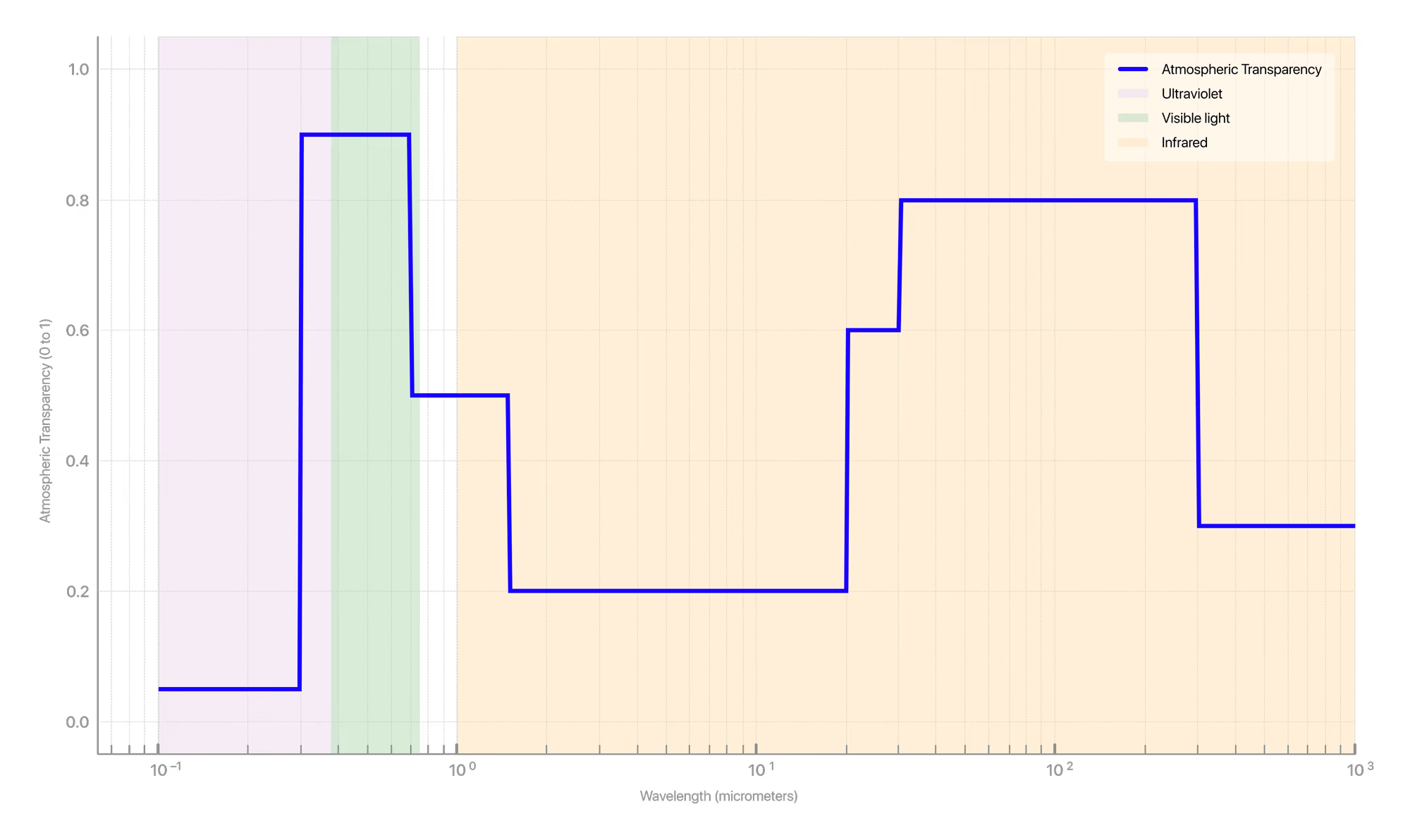
Cocconi and Morrison's reasoning was strikingly vivid: if two people agree to meet in an unfamiliar city but don’t specify a location, it makes sense to look for each other in the most obvious spot—say, the main square. In the context of interstellar communication, such a "square" could be a frequency universally understandable to any advanced civilization. And the spectral line of neutral hydrogen was the perfect candidate for that role.
Interestingly, this exact logic worked at least once—on Earth. In that same year, 1959, independently of his Cornell colleagues, a young astronomer at the National Radio Astronomy Observatory in Green Bank, Frank Drake, conceived a similar experiment. When selecting a frequency where an alien signal might plausibly be heard, he too chose the "hydrogen line." His project was named Project Ozma—after Princess Ozma from L. Frank Baum’s Land of Oz, a symbol of reaching out to another, as yet unreachable, world.
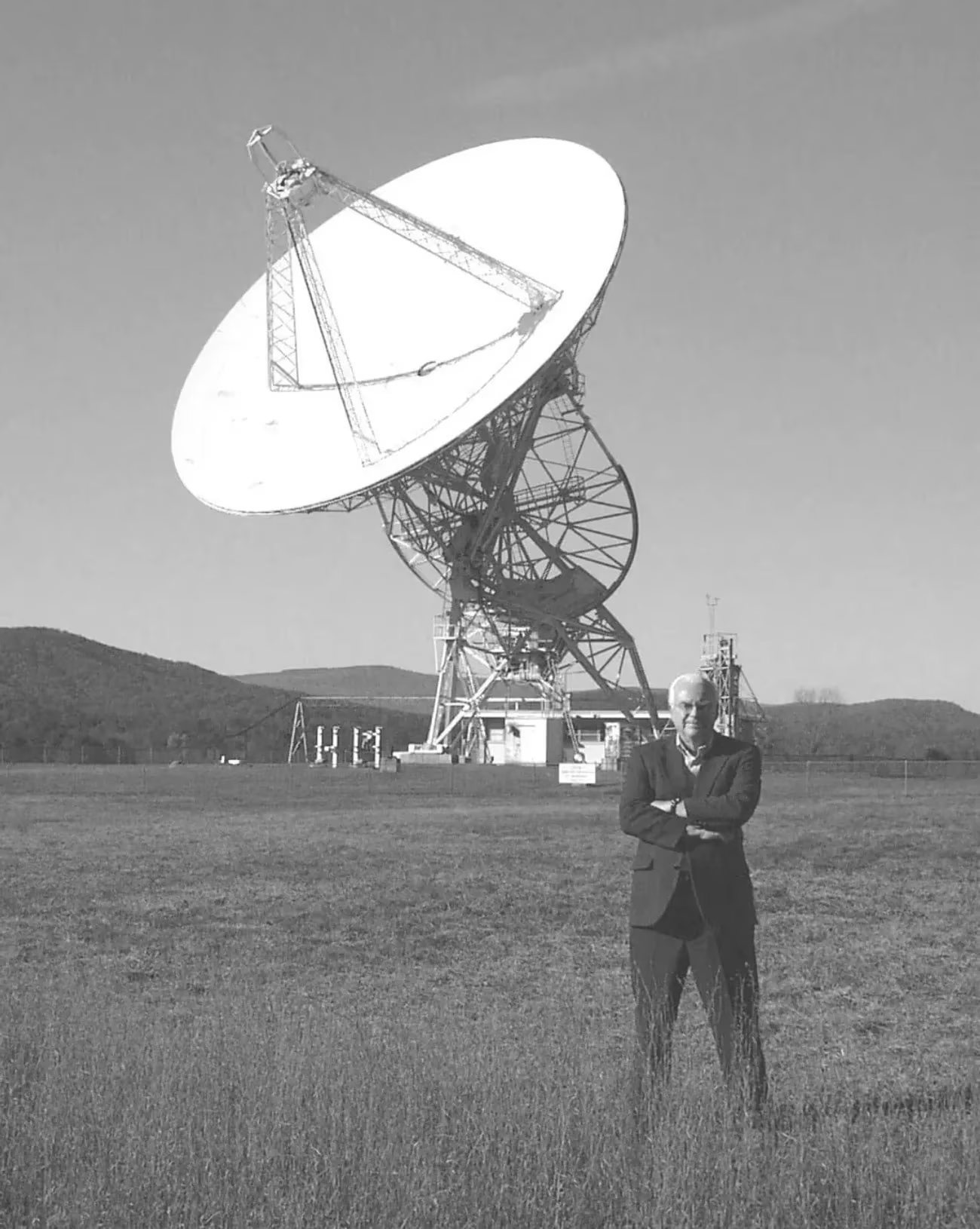
Frank Drake in front of the Howard Tatel Telescope, used for Project Ozma.
Formalizing the Vision: Otto Struve’s Role, the Green Bank Conference, and the First Systematic Approaches
One of the key figures whose support proved critical for SETI’s early development was Otto Struve—a descendant of the famed Russo-German astronomical dynasty and grandson of Otto Wilhelm Struve. After studying at the Faculty of Physics and Mathematics at Kharkiv University and enduring the horrors of World War I, he left Russia in 1920 with the evacuated White Army forces from Crimea. He later settled in the United States and devoted his life to astronomy.
By 1959, when Morrison, Cocconi, and Drake were independently pondering the possibility of communication with extraterrestrial civilizations, Struve was serving as the first permanent director of the National Radio Astronomy Observatory in Green Bank—effectively giving the "green light" to these bold ideas.
A lifelong expert in stellar spectroscopy, binary systems, and the interstellar medium, Struve once even hypothesized the existence of planets beyond our Solar System—long before exoplanets became a confirmed and active field of research. His public lectures at Berkeley and Cornell inspired an entire generation of young scientists, including Frank Drake.
But Struve’s most significant legacy in the context of SETI was his firm and unusually outspoken belief, for that time, that life in the Universe is not unique to Earth. In the early 1960s, he was one of the few astronomers who publicly declared that intelligent life around other stars is not just possible—it most likely exists. He put it in simple, compelling terms: even if the probability of life emerging in any given location is vanishingly small, that probability becomes meaningful when the "number of attempts" is truly cosmic in scale. And by all accounts, the Universe is exactly that.
"It is probable that many of the billions of planets in the Milky Way host intelligent forms of life. To me, this conclusion is of great philosophical interest. I believe that science has reached a point where, in addition to the classical laws of physics, the actions of intelligent beings must also be taken into account."
Otto Struve, daviddarling.info
Otto Struve, daviddarling.info

Otto Struve.
The first tangible result of the early SETI enthusiasts' efforts was a closed-door meeting organized by the U.S. National Academy of Sciences at the Green Bank Observatory. Its goal was strikingly ambitious: to develop a strategy for the systematic search for intelligent signals from space. The gathering brought together key figures: Frank Drake, Giuseppe Cocconi, Philip Morrison, Otto Struve, astrophysicist Su-Shu Huang, neurobiologist John Lilly, and biochemist Melvin Calvin. During the meeting, Calvin learned he had just won the Nobel Prize in Chemistry—but according to Drake's recollection, he remained "cool as a cucumber" and calmly continued the discussion. Also in attendance were Bernard Oliver, vice president of research at Hewlett-Packard, and a young but already charismatic Carl Sagan. The meeting’s atmosphere was so inspiring and unusual that, joking about the presence of dolphin researcher Lilly, the group dubbed itself the "Order of the Dolphin." Later, they even received commemorative medals bearing an image of the animal—a symbol of the aspiration to communicate with other intelligences, whether underwater or beyond Earth.
At the Green Bank meeting, participants attempted to explore the full range of possible methods for establishing contact with extraterrestrial intelligence. But the conversation wasn’t limited to technical matters—human factors were on the table, too. Frank Drake raised a question that would challenge every generation of SETI scientists: how do you stay motivated when all you get back is silence? He offered a pragmatic solution: combine the search for alien signals with other astronomical observations, so that even in the absence of contact, researchers would still collect valuable scientific data.
Otto Struve, for his part, pointed to a different obstacle—politics. In his view, government officials responsible for funding science would be skeptical of interstellar communication projects. And that skepticism would inevitably slow SETI’s development. History proved him right—again and again.
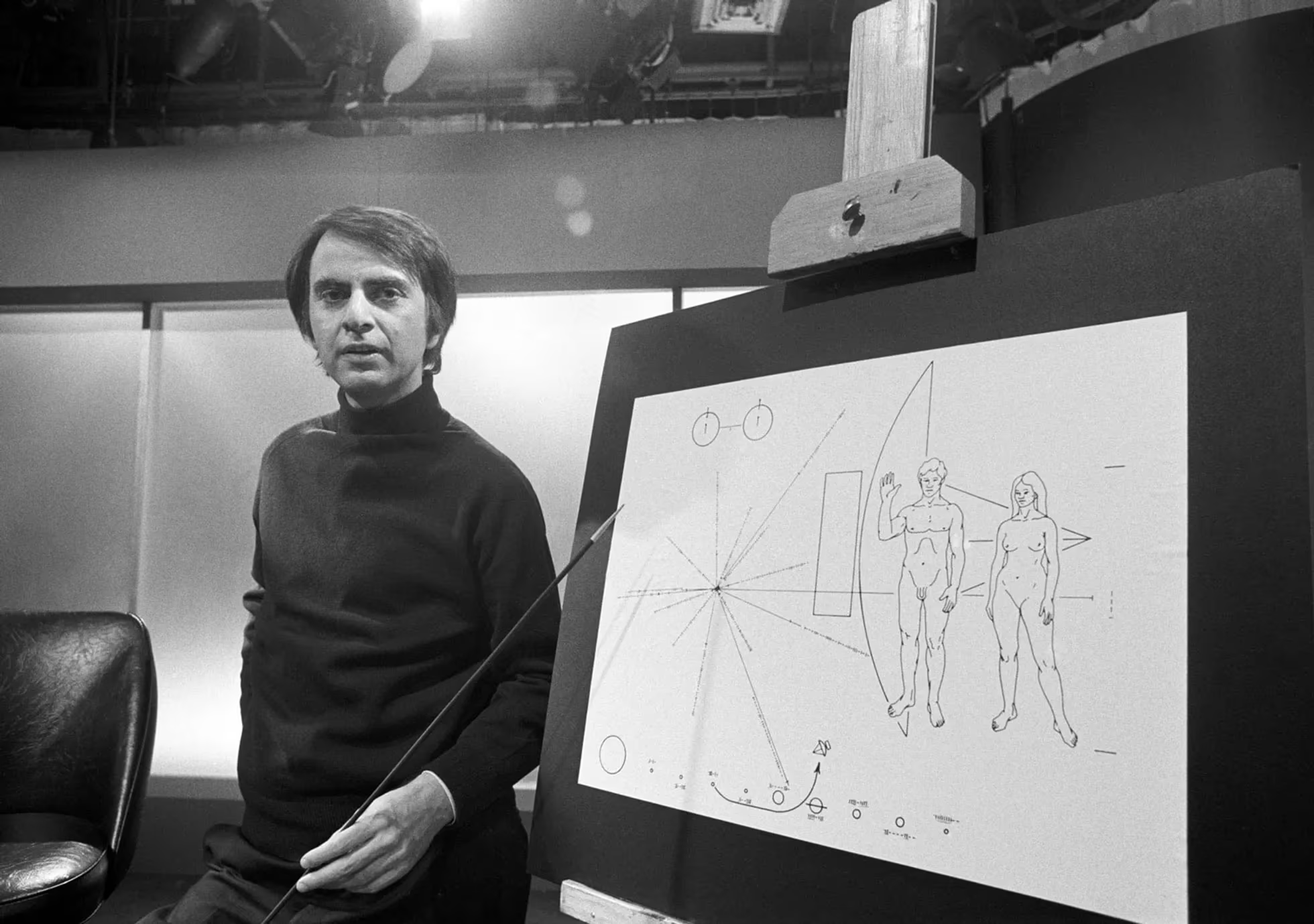
Carl Sagan in 1974.
The most famous outcome of the Green Bank meeting was the so-called Drake Equation—the first attempt to formalize the question: how many advanced civilizations might exist in our galaxy and be capable of contacting Earth? The equation took the form of a set of multiplicative factors, each representing a stage on the path to intelligent life. It included parameters such as the average rate of star formation in the galaxy, the fraction of stars with potentially habitable planets, and the likelihood that intelligent life and technological capability for interstellar communication would develop on such worlds.
Beyond the equation, the conference had a more unexpected result. Inspired by the discussions, Frank Drake devised an experiment—a first "message" to hypothetical extraterrestrials, known as the Drake Cryptogram. It was a coded sequence of 1,271 ones and zeroes, forming a simple but logically structured message. At the end of the meeting, Drake handed it out to all participants—as a live test: could even brilliant scientists decipher a transmission without any context? Of the entire group, only one—engineer and Hewlett-Packard vice president Bernard Oliver—managed to figure it out. It became clear rather quickly: establishing contact with an alien intelligence is far harder than just picking the "right" frequency.
Later, Frank Drake—this time in collaboration with Carl Sagan—crafted a new message for extraterrestrial civilizations, no longer theoretical but entirely real. It was transmitted in 1974 using the powerful Arecibo radio telescope in Puerto Rico. The target was the nearest globular star cluster—M13. Technically, the message was sent. In practice—it’s still en route. The radio signal from the 1970s will take around 25,000 years to reach M13. If anyone out there is listening, the reply will take a very long time. A very long time indeed.
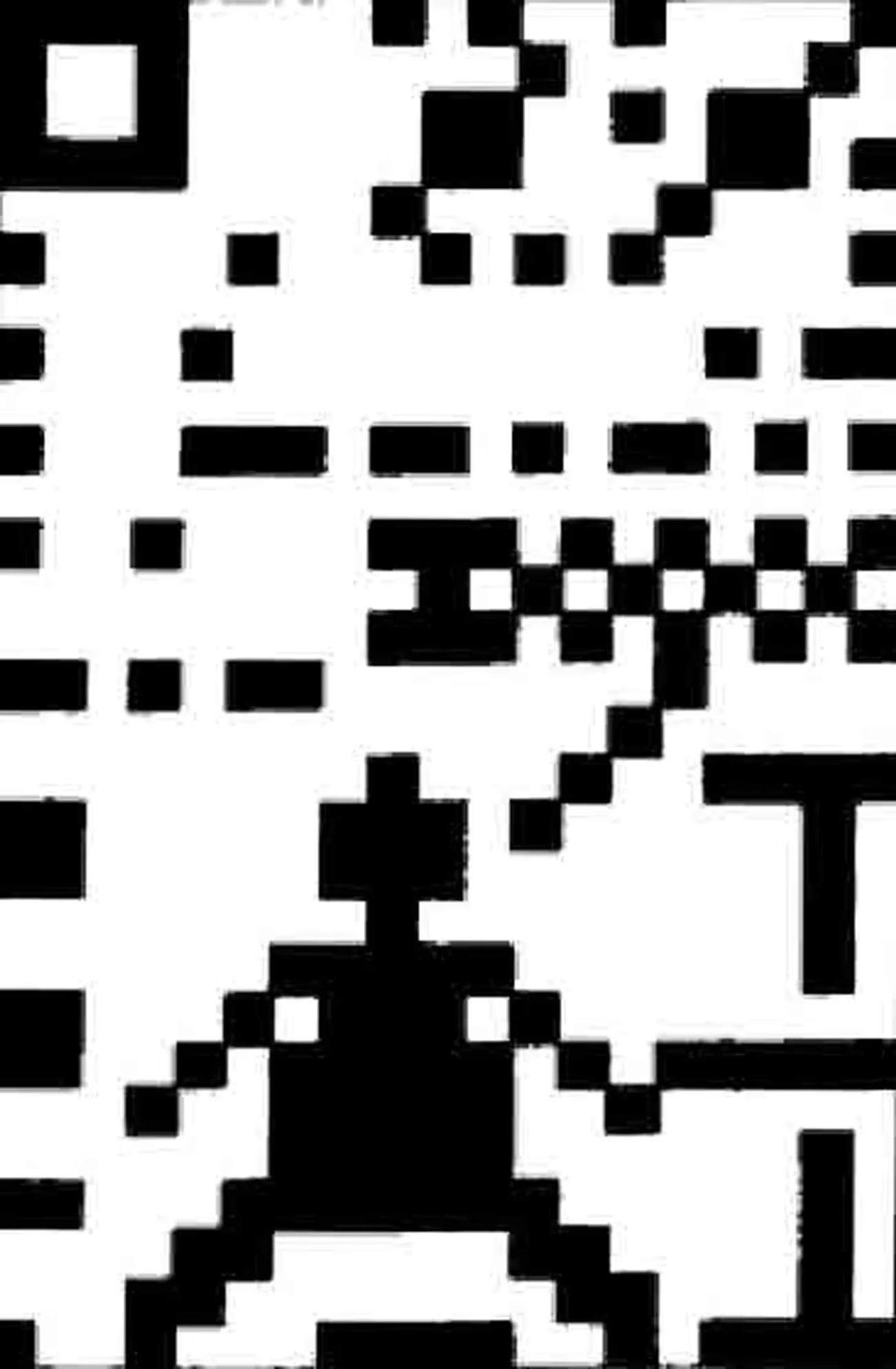
Decryption of the "Drake Cryptogram".
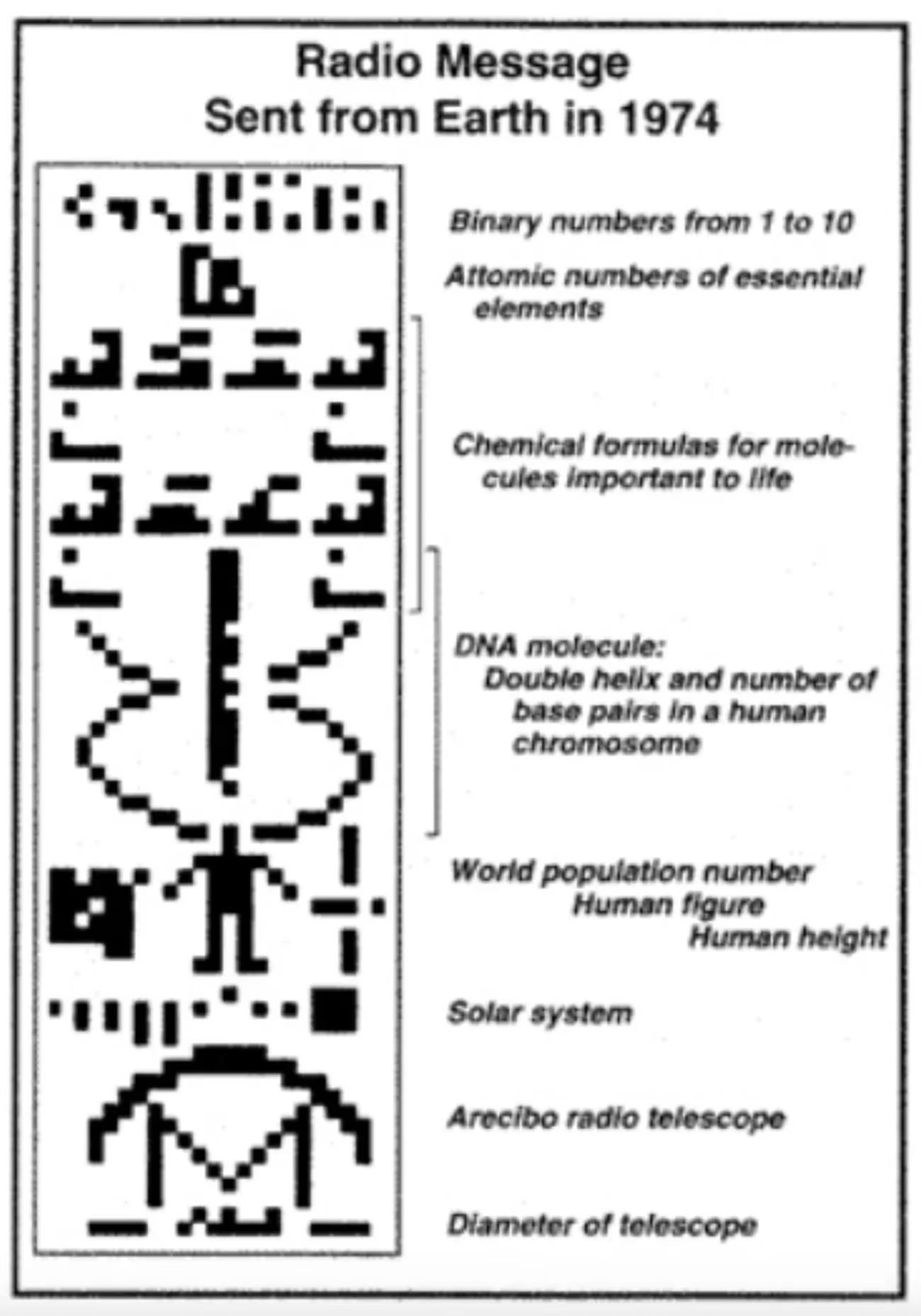
The Arecibo message to the globular star cluster M13.
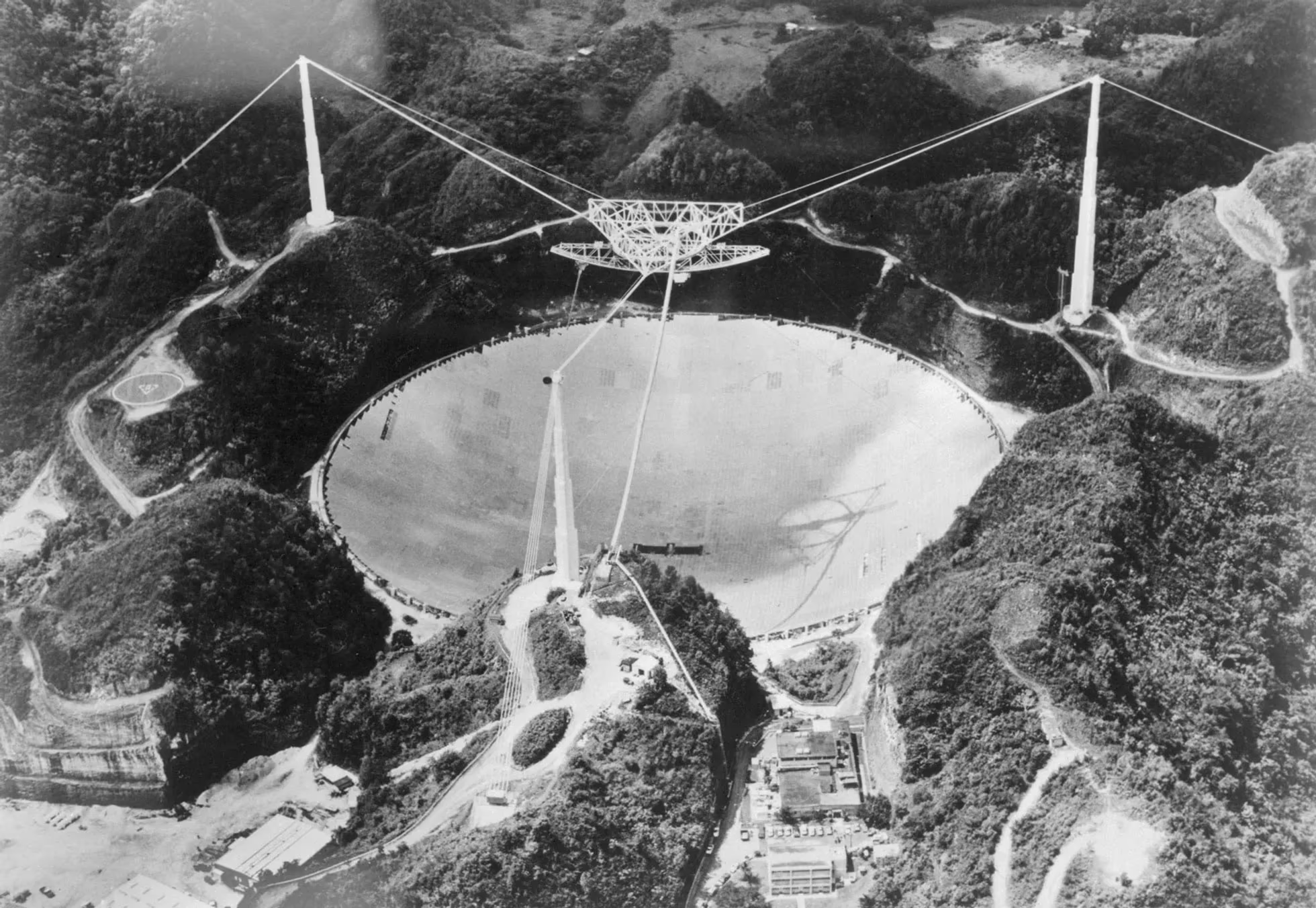
The Arecibo radio telescope.
After the completion of Project Ozma, SETI observations in the U.S. were temporarily suspended—throughout the late 1960s, American scientists focused primarily on theory. But the ideas of Cocconi, Drake, and Morrison resonated beyond the Iron Curtain—in the Soviet Union. As early as 1960, astrophysicist Iosif Shklovsky published an article titled "Is Communication with Intelligent Beings from Other Planets Possible?" in the journal Priroda (Nature), inspired by the experiments of his American counterparts. Two years later, his book Universe, Life, Intelligence was released—a manifesto of Soviet interest in the SETI topic. Soon theory gave way to practice. Under the leadership of radio physicist Vsevolod Troitsky, the USSR launched its first experiment in listening to space: using a radio telescope near Gorky (now Nizhny Novgorod), scientists scanned for signals from 11 nearby stars—and, for good measure, from the Andromeda galaxy.
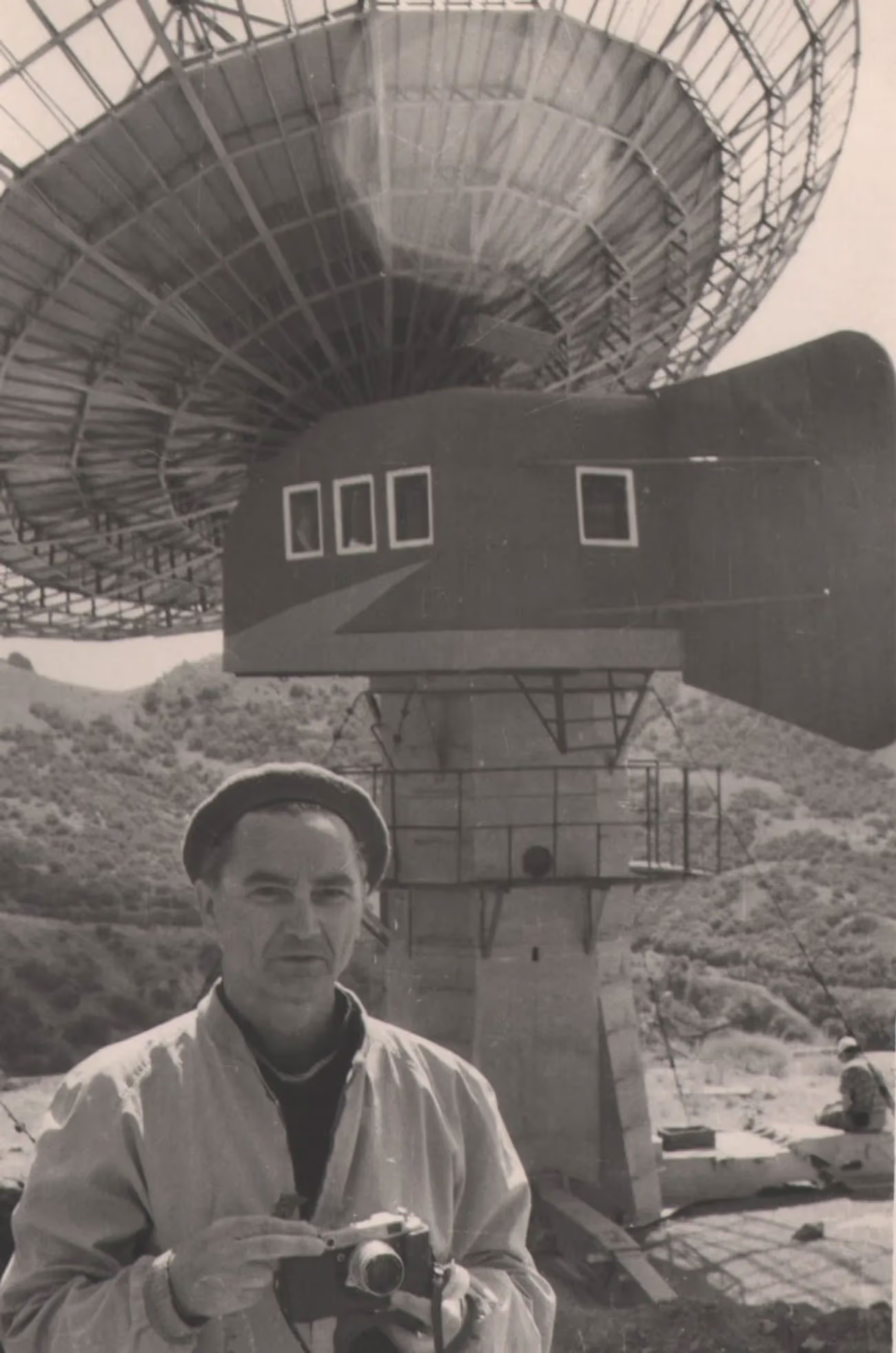
Vsevolod Troitsky.
Later, Carl Sagan and Soviet astrophysicist Nikolai Kardashev initiated the first Soviet–American conference dedicated to the possibility of contact with extraterrestrial intelligence. It took place in September 1971 at the Byurakan Astrophysical Observatory in Armenia and became a milestone for the entire SETI program.
Initially, the project was referred to as CETI—communication with extraterrestrial intelligence. But as it became clear that actual "communication" was still far off, the term began to shift. This led to the now-familiar SETI—search instead of communication, search instead of contact. The Byurakan conference brought together scientists from different countries, and the enthusiasm of American and Soviet researchers quickly spread across the world. SETI efforts were launched in Canada, Australia, France, Germany, Japan, Argentina, the Netherlands...
Throughout the 1970s, SETI remained a rare area where contacts between the USSR and the US were especially active. But by the end of the decade, the political climate had changed. The Soviet invasion of Afghanistan in 1979 cooled relations sharply—including in the scientific sphere.
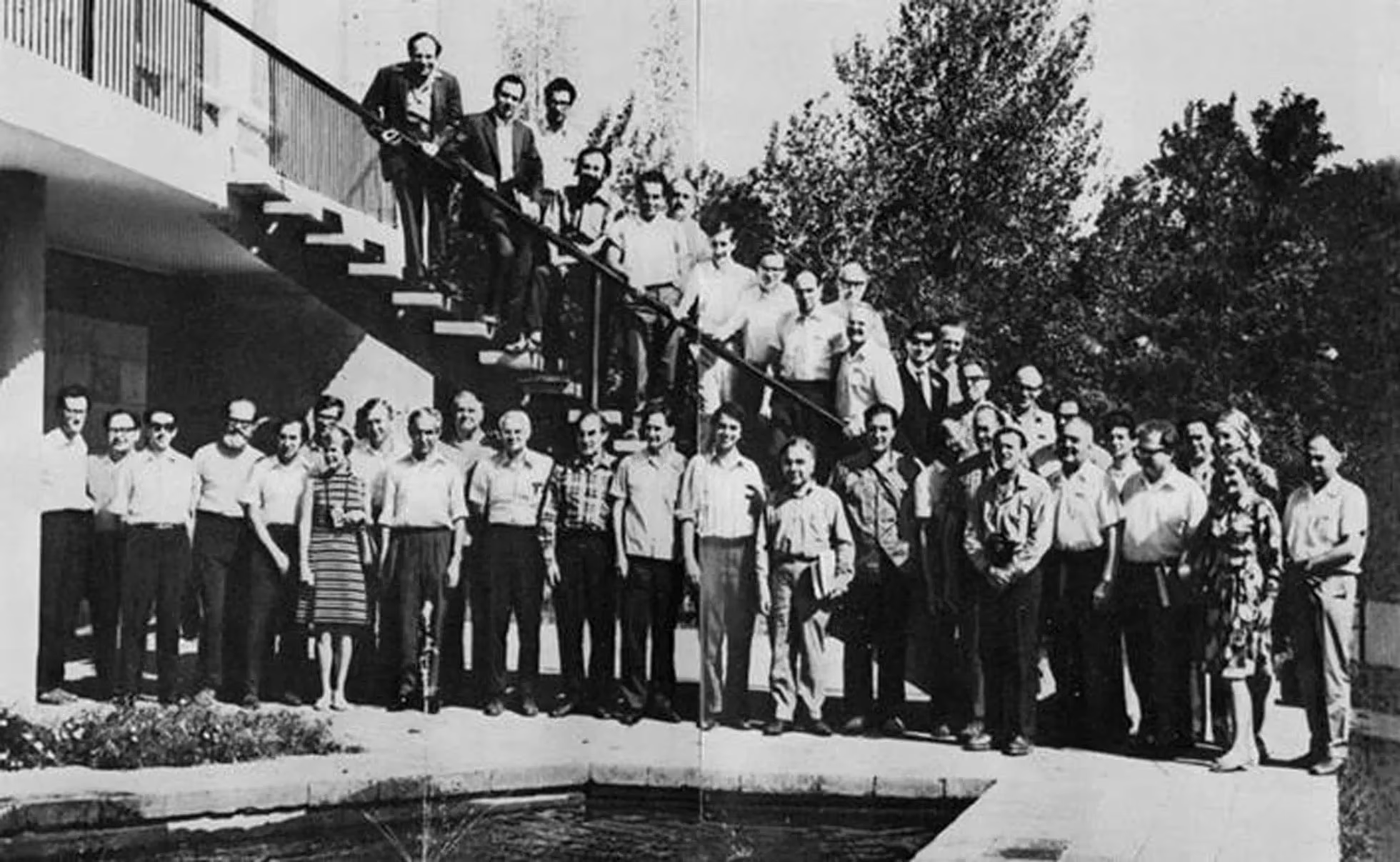
Participants of the CETI conference at the Byurakan Astrophysical Observatory in Armenia, September 1971.
Signals That Never Repeated: The Story of the "Wow!" Signal, Early Government Projects, and the Shutdown of the Radio Telescope
On the night of August 15, 1977, the Big Ear radio telescope in Ohio picked up a strange signal. It was brief, but exceptionally clear and powerful. When the astronomer analyzing the printout noticed the sudden spike, he couldn’t hold back his reaction—he circled the section and wrote a single word in the margin: "Wow!"
Thus, the "Wow!" signal entered SETI history as one of the most mysterious and still unexplained events. The signal was 30 times stronger than the typical cosmic background noise and, most remarkably, it arrived exactly at the hydrogen line frequency—the very one Morrison, Drake, and other SETI founders had deemed optimal for interstellar communication.
"Wow!" became more than just an emotional outburst—it became a symbol of the entire SETI endeavor: brief, full of hope, but still without follow-up.
The Big Ear telescope was located in Delaware, Ohio, and operated by a local university. It wasn’t much to look at: a massive aluminum rectangle the size of three football fields, with reflective surfaces along the sides. Originally built for a large-scale radio sky survey (completed in 1971), the telescope was later repurposed for SETI—to listen for signals from beyond Earth.
It was this telescope that picked up the "Wow!" signal years later. That detection came during the third attempt to revive Project Ozma—and like the previous efforts, it ended in silence. The signal was never repeated. But for a fleeting moment, Big Ear gave hope that someone out there might have responded.
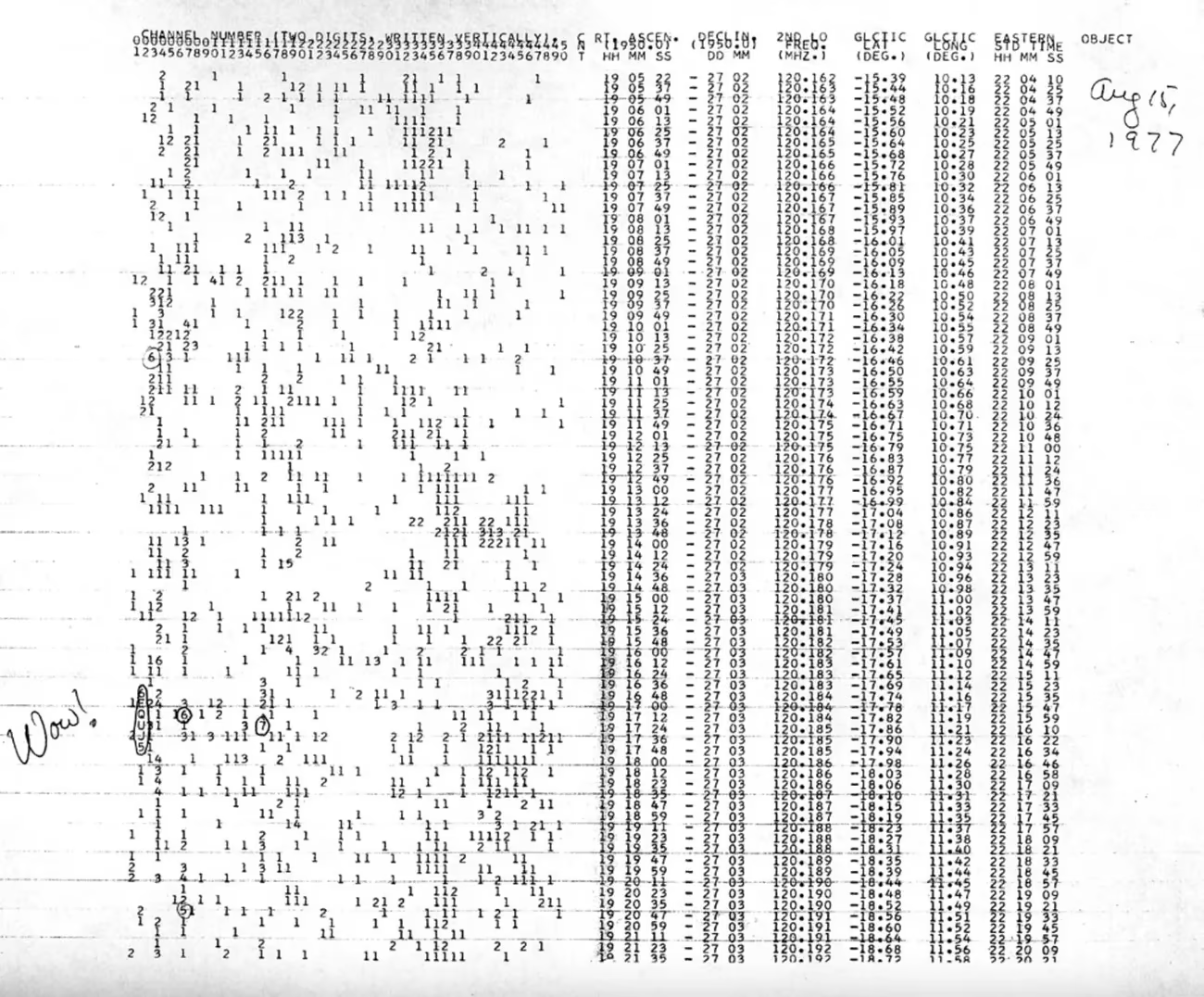
Printout of the data in which astronomers discovered the "Wow!" signal.
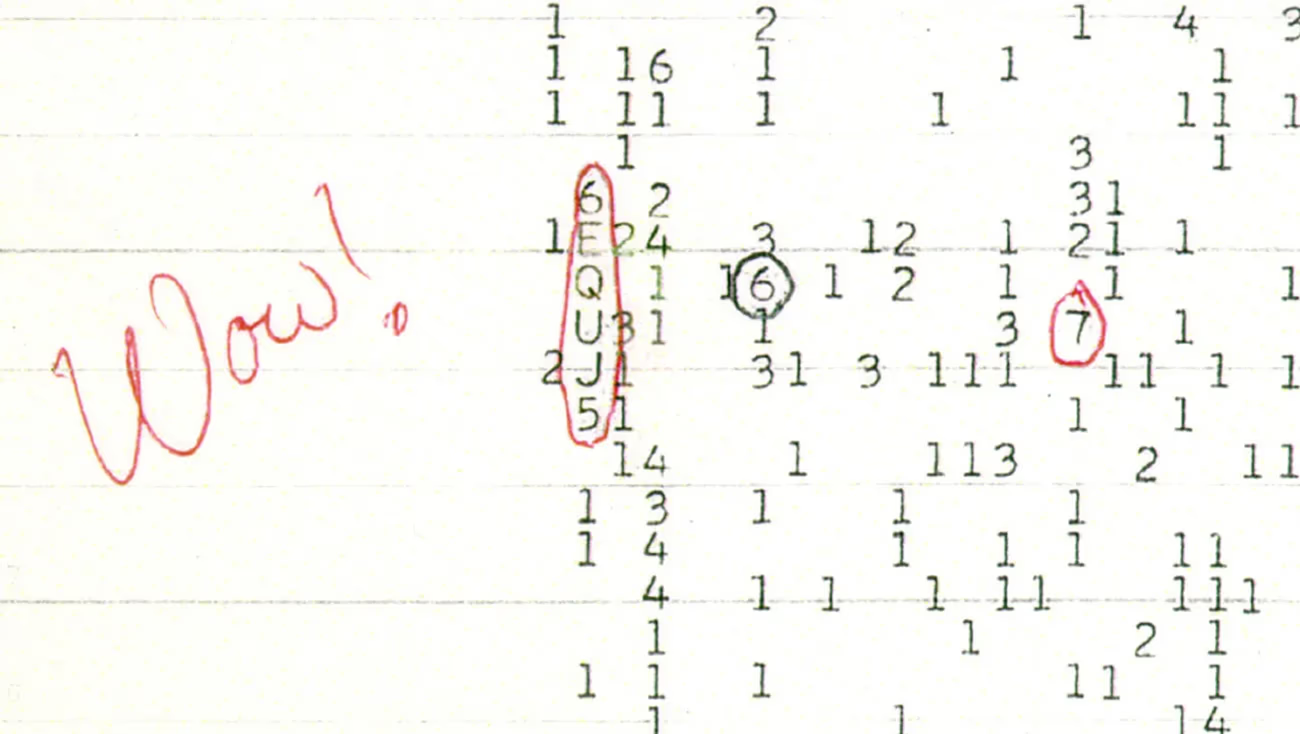
Fragment of the printout showing the signal with the famous annotation ("Wow!").
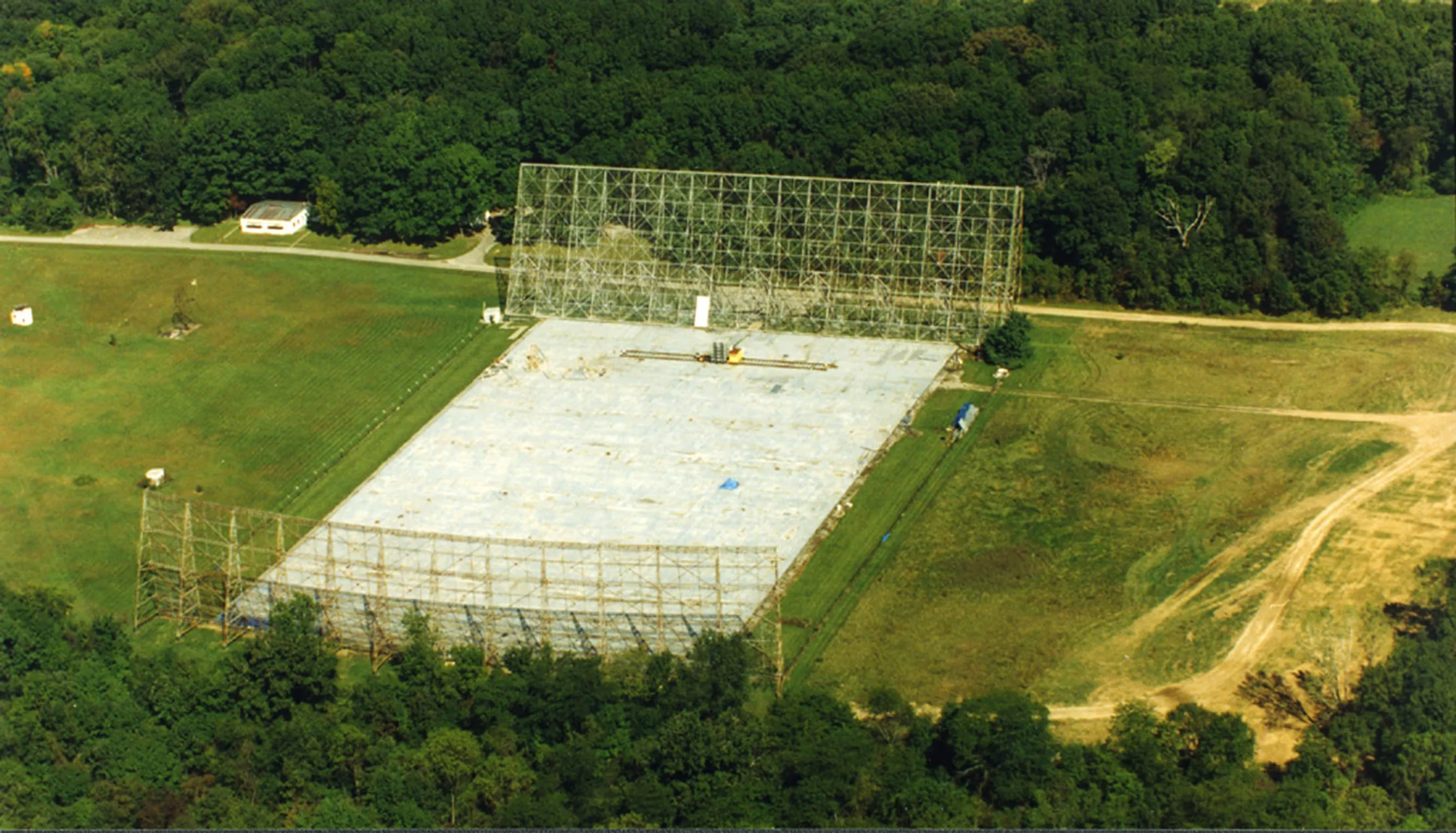
The Big Ear radio telescope.
Sadly, the brief flash of hope in 1977 was followed by a long period of disappointment. All subsequent attempts to detect anything resembling the "Wow!" signal ended in failure. Gradually, it became clear that a one-off spike—no matter how striking—could not be considered a true interstellar message. But if not a message, then what? Scientists could offer no convincing explanation, which sparked waves of speculation—from technical glitches to alien intervention. Only in 2017 did American astronomer Antonio Paris propose the most plausible theory: the source of the signal was likely not extragalactic, but much closer. It was probably a hydrogen cloud surrounding the nucleus of a comet that happened to be passing through the constellation Sagittarius at the time of the observation—almost 40 years earlier.
The story of Big Ear was not limited to one mysterious signal. The telescope made valuable contributions to astronomy—such as detecting previously unknown cold interstellar hydrogen clouds. In the early 1990s, it was even upgraded in anticipation of joining a new, ambitious SETI project called SERENDIP. But those plans never materialized. Back in the 1980s, the university—facing financial difficulties—sold the land where the observatory stood. In 1998, the outcome was sealed: developers prevailed, and on the site of one of SETI’s most iconic early telescopes, a golf course and suburban housing complex were built. Thus ended the story of the "ear" that tried too early to hear the voice of the universe.
The second key development for SETI in the 1970s was NASA’s involvement—a step that immediately gave the search for extraterrestrial intelligence both credibility and official backing. The plan was for two major U.S. agencies to join the effort: the Jet Propulsion Laboratory (JPL) and NASA’s Ames Research Center. JPL was to utilize the Deep Space Network—a system of powerful radio stations originally designed for communicating with interplanetary spacecraft. These antennas would be repurposed to systematically scan the skies for intelligent signals. Meanwhile, the Ames center would focus on stars similar to the Sun, using telescopes in Arecibo (Puerto Rico), Green Bank (USA), Parkes (Australia), and Nançay (France). Both groups aimed to observe in the 1000 to 3000 MHz range—close to key frequencies associated with hydrogen and hydroxyl (OH), believed to be natural "beacons" in the universe.
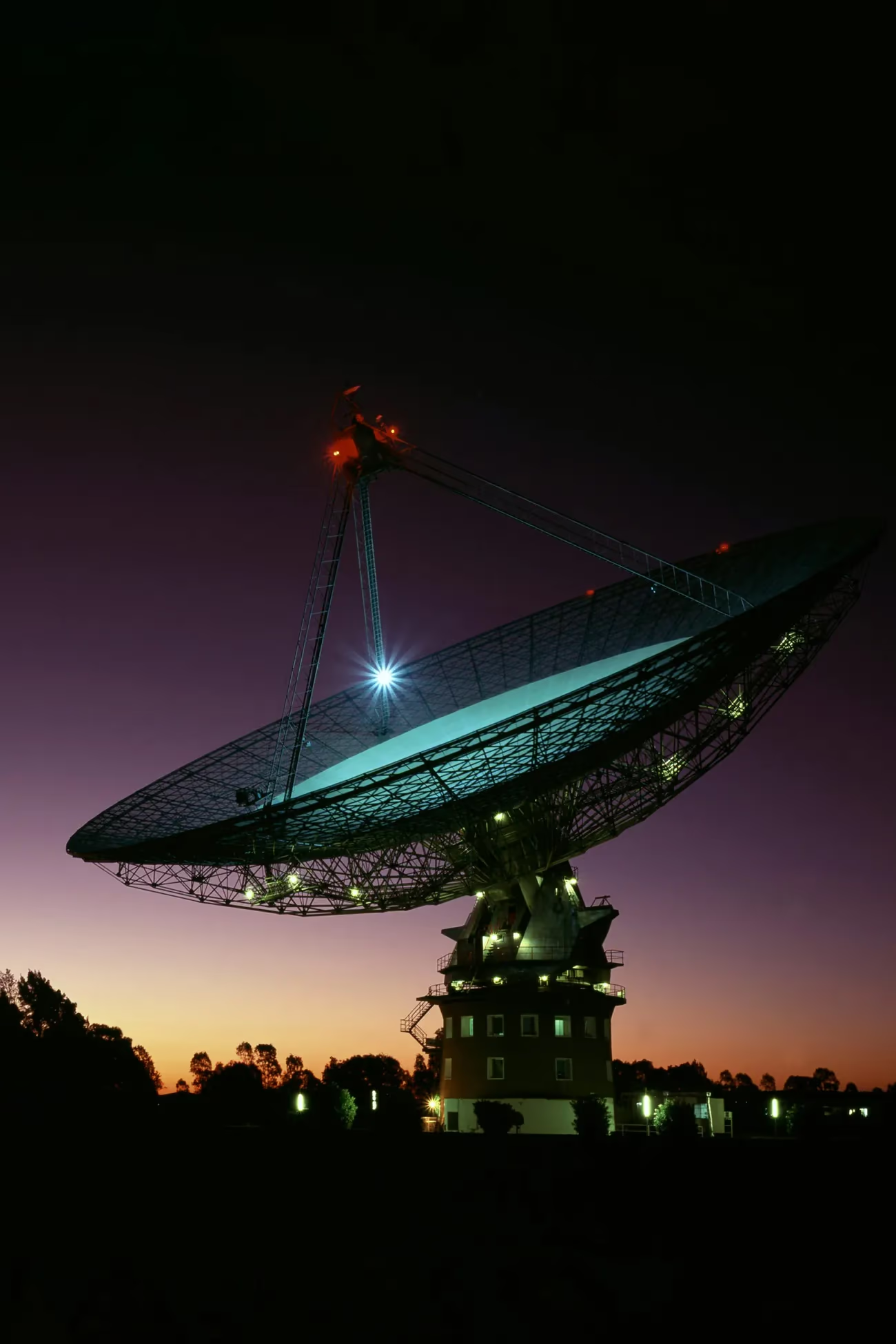
Parkes Observatory radio telescope, Australia.
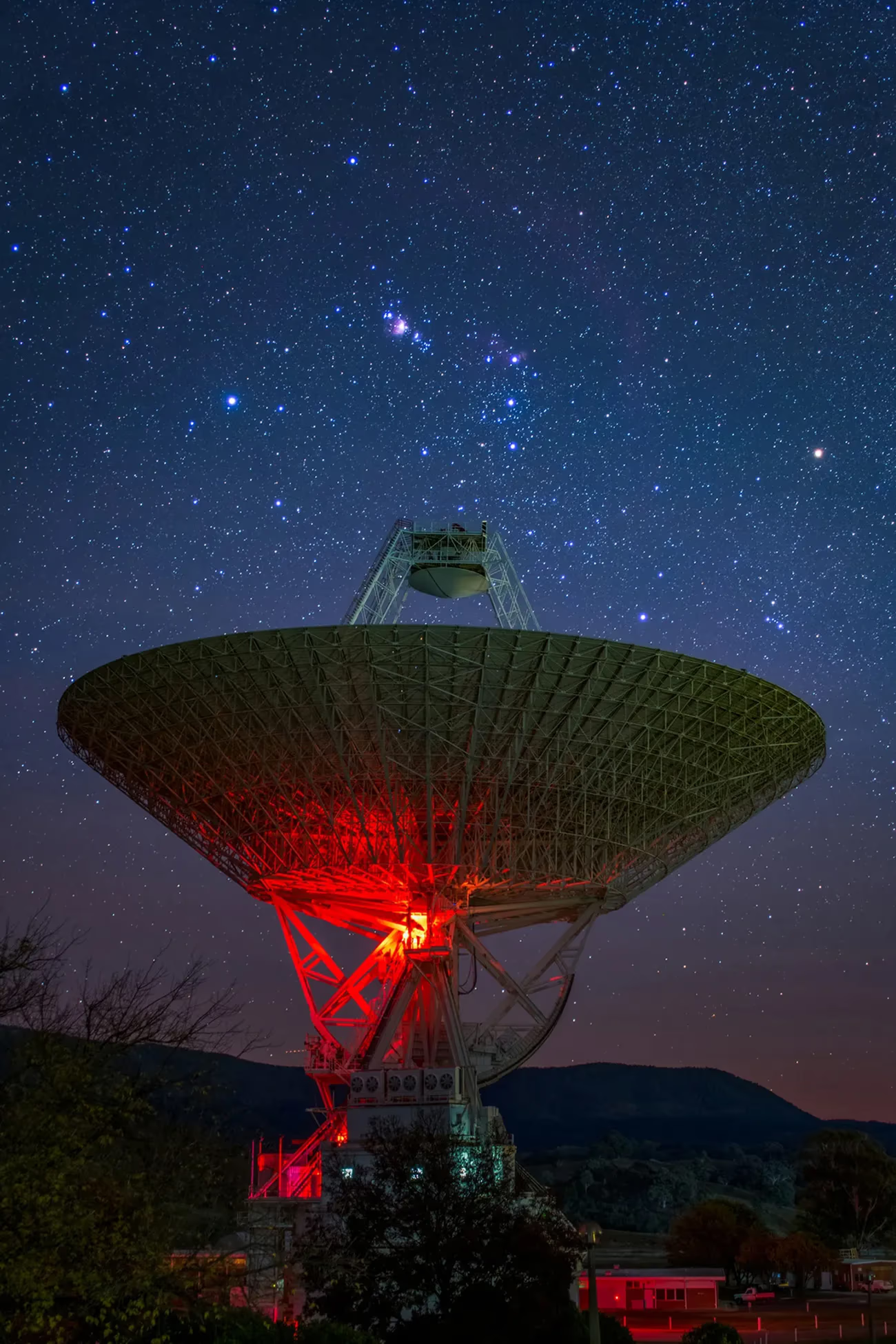
Deep Space Network station in Canberra, Australia.
But as soon as NASA announced its ambitious plans, it faced fierce opposition in Congress. The main opponent of the program was Senator William Proxmire, known for attacking what he considered "wasteful" scientific initiatives. According to him, the search for intelligent signals from space was nothing more than a frivolous waste of taxpayers’ money, and he flatly refused to fund what he called a "science fiction hobby." To save the program, it took the charisma of Carl Sagan himself. He secured a personal meeting with the senator and patiently explained that SETI was not just a philosophical experiment, but a challenge capable of stimulating cutting-edge technological development. As an argument, Sagan presented a petition in support of the project, signed by leading scientists from around the world, including Nobel laureates.
Proxmire gave in. The program received approval. But it would be almost another decade before real observations began: the project had to be meticulously refined and presented with caution to avoid renewed political backlash. Even its name was chosen to sound as neutral as possible—High Resolution Microwave Survey, with no mention of extraterrestrial intelligence.
Yet even after overcoming the political barrier, researchers ran into an unexpected obstacle—a financial-bureaucratic one. The problem was that NASA grants came with overhead costs: universities where the researchers worked retained a significant portion of each dollar awarded. At Stanford, for example, the rate reached 100%. This meant that for every dollar paid to a scientist working on a SETI project, NASA had to pay another dollar to the university. This arrangement frustrated many, including John Billingham, who oversaw SETI programs at the Ames Research Center. He proposed a radical solution: to create an independent organization that could directly hire scientists, bypassing the cumbersome university system—and for much less money.
This is how the SETI Institute came to be—officially registered in California on November 20, 1984. It began operations on February 1, 1985, marking a new chapter in the search for extraterrestrial intelligence—outside the walls of academic bureaucracy.
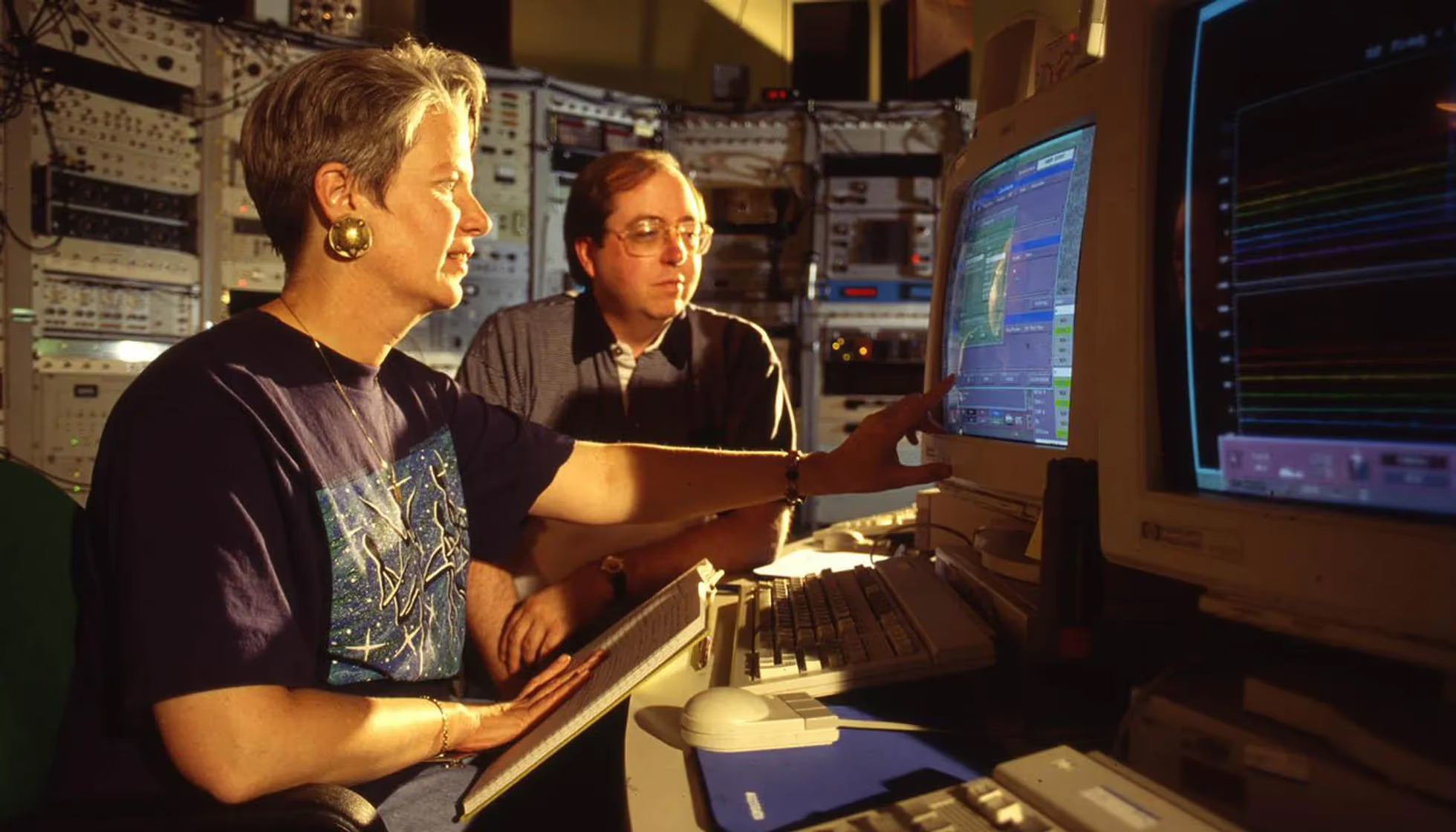
Jill Tarter with colleague Peter Backus at the Parkes Radio Telescope in Australia.
At the helm of the new institute were two key figures: the first executive director, Thomas Pierson, and astrophysicist Jill Tarter—the very same who would later inspire the main character in Carl Sagan’s novel Contact and Robert Zemeckis’s film of the same name. The institute relied on private funding, with a board of trustees established for that purpose. Among its first members were Frank Drake, and eventually Carl Sagan, renowned astronomer and science educator Andrew Fraknoi, Hewlett-Packard CEO Lew Platt, as well as Nobel laureates Baruch Blumberg and Charles Townes.
The SETI Institute settled in the very heart of the high-tech world—in Mountain View, Silicon Valley, between San Francisco and San Jose. Nearby sits NASA’s Ames Research Center, with which the institute forged close ties from the start.
Today, the SETI Institute operates three main branches: the Carl Sagan Center for the Study of Life in the Universe, an Education and Outreach Center for students and educators, and a Public Engagement division, which produces the Big Picture Science podcast and hosts SETI Talks—weekly public conversations with leading scientists and thinkers.
Breaking Free from Bureaucracy—and a New Tactic: The Birth of the SETI Institute, Distributed Computing, and Privately Funded Observations
The creation of an independent institute truly allowed for cost savings: administrative overheads were sharply reduced, and NASA transferred almost all research related to the search for extraterrestrial intelligence to SETI. But just as the work began, the program came under fire again—this time with far more serious consequences.
A sharp attack came from Senator Richard Bryan of Nevada. He demanded the immediate termination of funding for the already approved program and flatly refused to meet with anyone associated with it. Neither Carl Sagan’s personal charm nor the efforts of other SETI members helped. In 1993, after just one year of full-scale operations and $60 million spent, the "High Resolution Microwave Survey" was officially shut down.
Nevertheless, the SETI Institute managed to salvage part of the effort. Observation time at Arecibo and Parkes had already been approved, and the segment of the project led jointly with NASA Ames was relaunched under a new name—Project Phoenix. "Phoenix" gave the initiative a second wind: in 1995, systematic scanning of radio signals from Sun-like stars began, focusing on the 1000 to 3000 MHz range. However, the more ambitious part of the program—the full-sky survey using Deep Space Network antennas—could not be saved.
After a series of political blows and the realization of how vulnerable a science program dependent on government funding could be, SETI researchers began seeking alternative paths. One such path was to use existing astronomical observation data without requesting dedicated telescope time. This led to the birth of the SERENDIP project (Search for Extraterrestrial Radio Emissions from Nearby Developed Intelligent Populations) in the 1980s, launched by the University of California, Berkeley, with support from NASA and the National Science Foundation.
The key feature of SERENDIP was that it analyzed data collected during routine astronomical observations at major radio telescopes—including the famed Arecibo Observatory. This allowed SETI researchers to search for extraterrestrial signals "in the background" of other scientific work, without needing to divert expensive equipment solely for their use.
But this approach introduced a new challenge—data volumes grew rapidly, and processing them required massive computational power. The solution came in the form of a technological breakthrough: in 1999, Berkeley launched SETI@home—the first large-scale scientific distributed computing program. Millions of users around the world began downloading a special application to analyze radio signals on their home computers.
SETI@home became one of the most expansive crowdsourced experiments in the history of science. Before the project concluded in 2020, more than 5.2 million volunteers had taken part. The platform created for it—BOINC (Berkeley Open Infrastructure for Network Computing)—later powered dozens of other scientific initiatives, from Alzheimer’s research to climate modeling.

Allen Telescope Array in Hat Creek, California.
In the early 2000s, SETI researchers proposed a new strategy: to abandon the idea of one giant radio telescope in favor of an array of smaller antennas. This approach proved to be more cost-effective and allowed for much wider sky coverage. In 2007, with financial support from Microsoft co-founder Paul Allen, the Allen Telescope Array (ATA) began operating at the Hat Creek Observatory—42 synchronized dishes, originally envisioned as part of a much larger array of 350 units. But due to funding shortages, SETI settled on the number 42—a nod to Douglas Adams and his famous "answer to the ultimate question of life, the universe, and everything."
Today, the ATA network is used for two major lines of research. The search for intelligent signals is funded exclusively through private donations—a core principle of the institute. Research into the origins and evolution of life in the universe, however, is largely supported by NASA.
SETI scientists are actively involved in key space missions—from automated probes and Mars rovers to the New Horizons flyby of Pluto and asteroid studies. They also play a major role in processing data from the Kepler telescope and in the systematization of exoplanets—new worlds where one day, perhaps, we might hear an answer to our question: are we alone in the universe?
The Return of Interest Through Private Initiative. Support from Tech Elites and Expanding the Frontiers of the Search
In 1978, Carl Sagan once again made SETI a national conversation topic—this time through television. During one of his frequent appearances on The Tonight Show, he discussed the search for extraterrestrial intelligence in depth with host Johnny Carson. For the pre-internet era, such broadcasts were among the only ways to reach a wide audience directly. And Sagan used the opportunity brilliantly—speaking simply, compellingly, and with genuine enthusiasm, he presented the possibility of contact with other civilizations as a real scientific challenge that could reshape our understanding of the universe.
"We are at a very dangerous moment in human history. We have weapons of mass destruction, we’re in the process of unintentionally changing the climate, depleting fossil fuels and minerals—all kinds of problems brought on by technology. We're not sure we can survive this period I like to call the technological adolescence. But if we received a message from somewhere else, it would show that surviving is possible. And that would be very useful information."
Carl Sagan, planetary.org
Carl Sagan, planetary.org
Sagan’s words continue to inspire—not just scientists, but also those willing to support science financially. In 2023, the SETI Institute received the largest donation in its history: $200 million. The funds were bequeathed by Franklin Antonio, co-founder of Qualcomm and a longtime supporter of the search for extraterrestrial intelligence. For more than a decade, he backed the Institute’s work—and continued to do so even after his death.
Interest in fundamental science—and in the "ultimate questions of life, the universe, and everything"—is shared by other tech elites. One of them is Russian-born investor Yuri Milner, who emigrated to the U.S. In 2012, he founded the Breakthrough Prize—an annual award for scientists making significant contributions to fundamental physics. The prize later expanded to include life sciences, mathematics, and astronomy.
Against the backdrop of renewed interest in big questions, SETI remains one of the few projects where science, imagination, and real funding continue to move in the same direction—despite decades of cosmic silence.
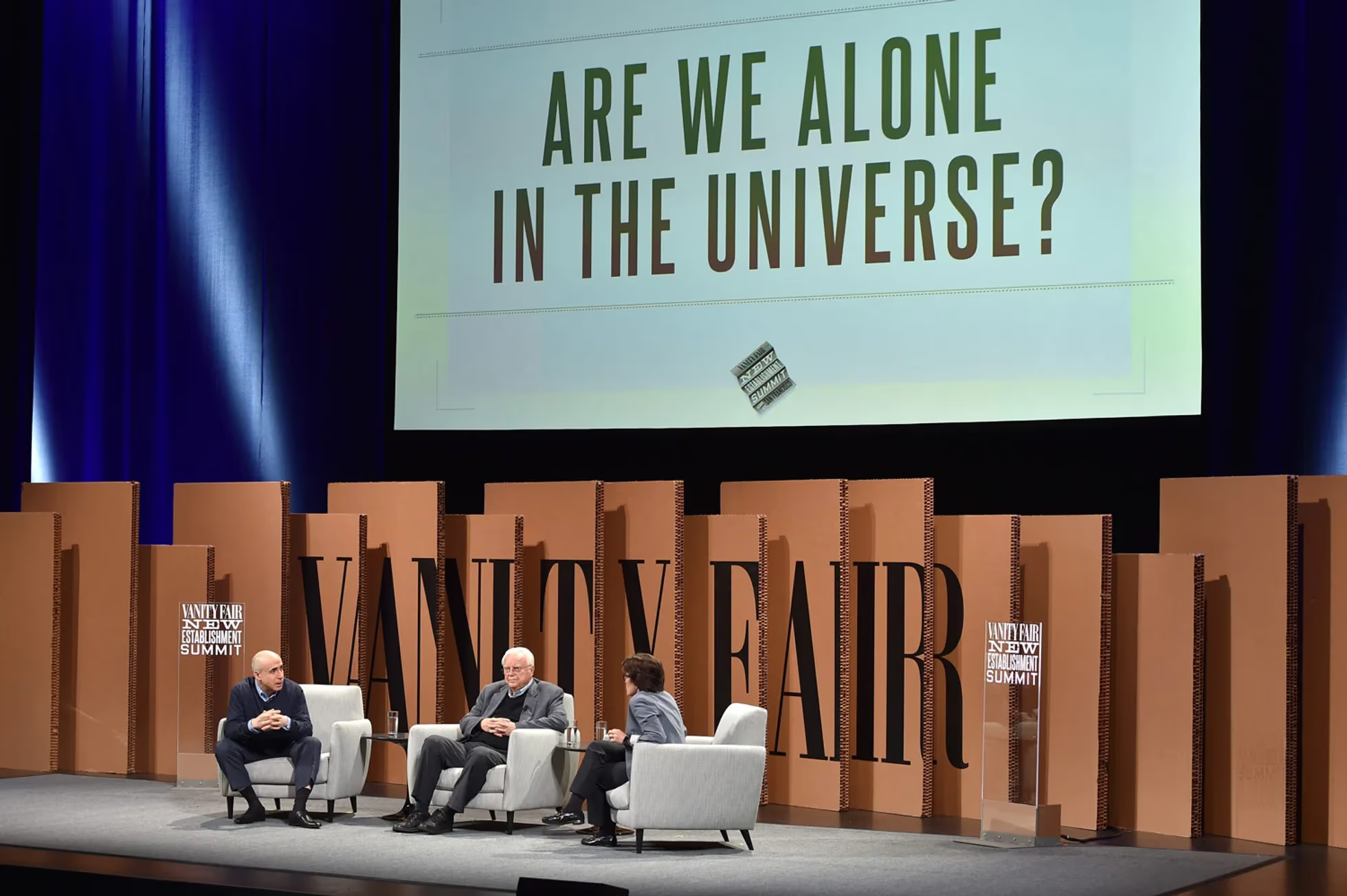
Yuri Milner (left) and Frank Drake (center) during a panel discussion with journalist Kara Swisher at the Vanity Fair New Establishment Summit in San Francisco, October 7, 2015.
In 2015, Pete Worden, then director of NASA’s Ames Research Center, learned that Yuri Milner had developed an interest in the search for extraterrestrial intelligence—and was willing to support it financially. This led to the creation of Breakthrough Initiatives, through which the billionaire began investing in ambitious scientific projects: from the search for life beyond Earth and the study of exoplanets to the development of miniature spacecraft with laser sails capable of reaching the Alpha Centauri system. That same year, Worden left NASA and became executive director of Breakthrough Initiatives.
By that time, two major institutions were leading the global search for extraterrestrial intelligence: the SETI Institute and the affiliated SETI Research Center at the University of California, Berkeley. Ultimately, the Berkeley-based center received funding for a new project—Breakthrough Listen. Milner pledged $100 million for a ten-year program.
The SETI Institute remained outside the core funding, though three of its representatives—including Jill Tarter—joined the project’s advisory board. Breakthrough Listen uses radio telescopes in Green Bank (USA) and Parkes (Australia) to scan millions of stars within about 1,000 light-years of the Sun, as well as the plane of the Milky Way and the 100 closest galaxies. Parallel observations are also conducted in the optical spectrum using the Automated Planet Finder at Lick Observatory.
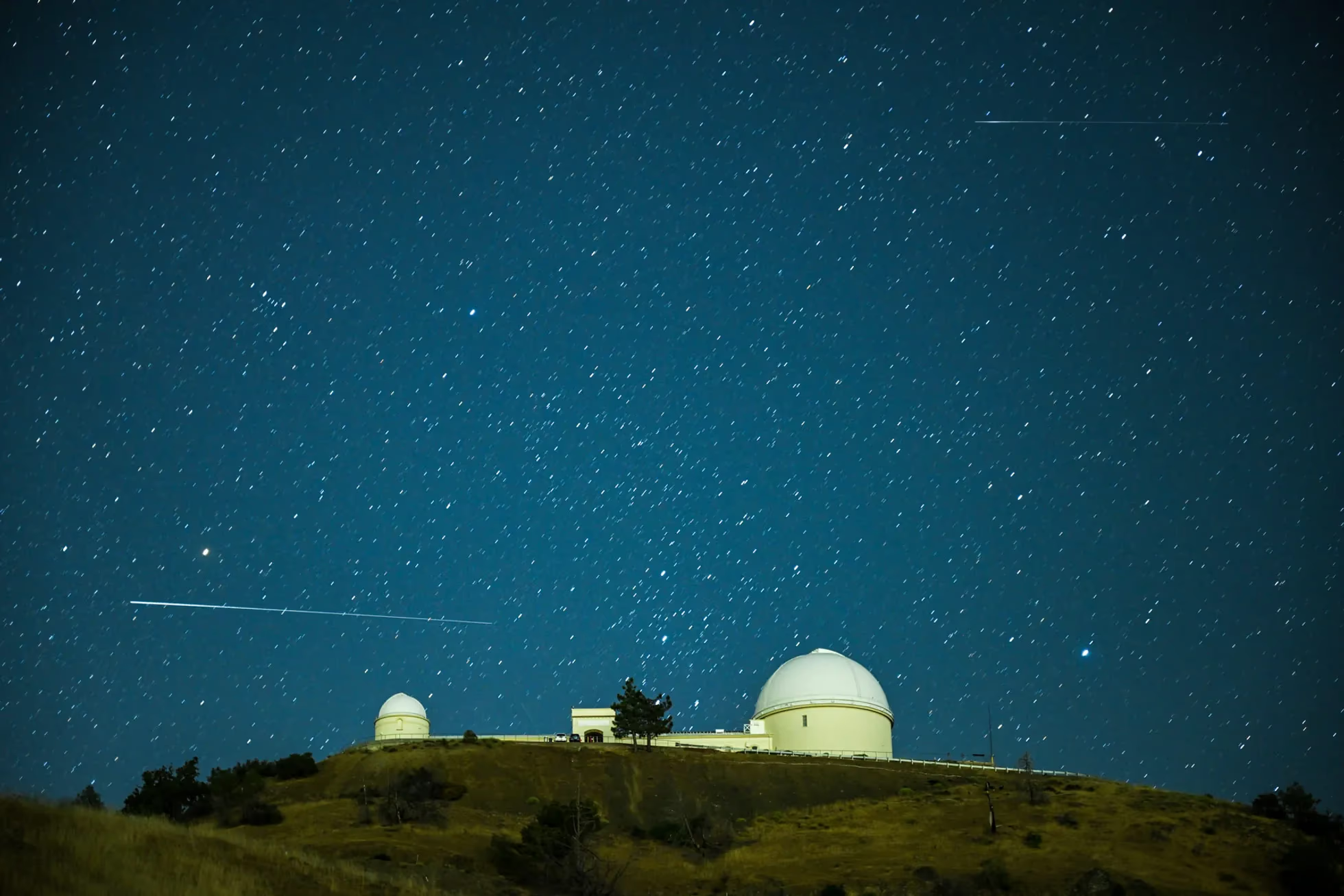
Lick Observatory in California, 2023.
Yuri Milner's project is already bearing tangible fruit. Thanks to his funding, the world's largest radio telescopes have been able to continue operating—despite recent cuts to public budgets. Moreover, under the Fast Radio Bursts (FRB) program, researchers have begun systematically recording so-called fast radio bursts—millisecond-long pulses of radio energy whose origins remain a mystery.
Today, Breakthrough Listen and the SETI Institute are conducting the most extensive targeted search for artificial signals from space in history. The telescopes involved cover a frequency range from 1,000 to 15,000 MHz—by comparison, NASA's original program was limited to 3,000 MHz. In parallel, new approaches are being developed: SETI scientists are increasingly exploring the potential of optical and near-infrared signal detection.
Next-generation infrastructure is also being built. One of the most promising projects is the Square Kilometre Array in South Africa and Australia—a massive array of compact radio telescopes originally designed for traditional astronomical observations but with potential SETI applications. With new algorithms and machine learning systems, researchers are now better able to filter out false signals and manage massive datasets more effectively.
The universe remains silent. More than half a century after Project Ozma was launched, the Fermi Paradox—"if intelligent life exists, where is it?"—remains unanswered. But SETI scientists aren’t giving up. They keep searching. And they keep inventing—not just new ways to listen to the cosmos, but new ways to keep believing it will someday respond.
Far from Earth
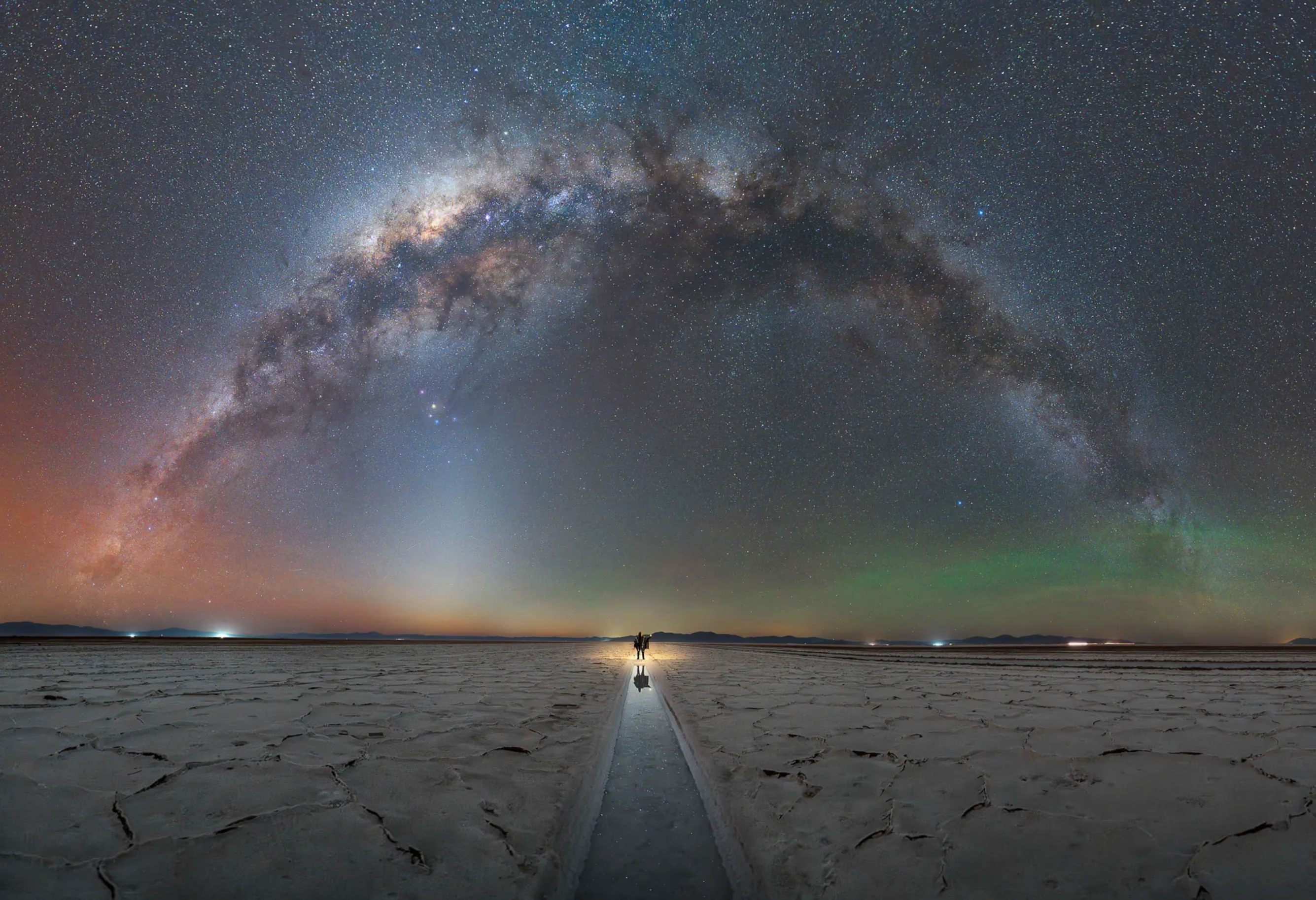
The Milky Way From All Corners of the Earth
Stunning Images From the Annual Capture the Atlas Photo Contest

Soviet Spacecraft Falls to Earth Half a Century After Failed Mission to Venus
Uncontrolled Reentry Expected in Coming Days as the Craft Weighs Over Half a Ton

